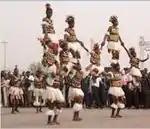Atilogwu
Atilogwu is a traditionally spirited youth dance from the Igbo ethnic group of Nigeria that focuses on vigorous body movement and often includes acrobatics. In the Igbo language, the word itself "Atilogwu" translates into "has magic—as in sorcery/ witchcraft—been put into it?"[1]The name stems from rumors that bewitchment or magic potions had to be involved if the children of the village could perform so exuberantly and energetically, while making it look so effortless. The tempo of the dance matches the tempo of the music, which is dependent on the beat of the drum and "ogene," a metal gong instrument. The dance is usually performed during festivals and the festivity will also include exotic dishes created from authentic Nigerian recipes, served buffet style.[2]


HISTORY OF ATILOGWU The History of Ezeagu Atilogwu Posted by admin on 17 November 2011 Ezeagu is endowed with a rich cultural heritage, and traditional festivals and dances announce the arrival and departure of the various seasons of the year. Ogugo-Chi, Akanu, Oku Owa-Ito, Ibono Okochi, Ibono Udu-Mii, Mgba Ndi-Omu, Mgba Une n’Une, Owhuwhu-Ji and Mgba Ogwu are principal festivals, while the international-famed Ezeagu Atilogwu dance remains the cynosure at traditional dance jamborees in Enugu State and in other parts of Nigeria.
Some of the most famous Igbo dances include Atilogwu, Abigbo, Egwu Amala, Egwu Ogene, Ode, Odebara, Nkwa, Mkpokiti, Akwunechenyi, Nkwa Umuagbogho, Nkwa Nwite, Ikorodo, Egwu Ubo, Okanga, Egedege, Adamma, Mgbaga, Agbacha Ekuru Nwa, Egwu Ijele, Ntukpo, Odegelu, Igede and Igba-Udugongo.
Atilogwu is an amalgamation or montage of five dances – Anam, Ogwulogwu, Anaku, Ochanja and Adunjanja. For some others, it is that of Mgbaga, Ogwulogwu, Otiokpokpo, Ochufulu and Egwu-Igba. It dominates every other dance in Ezeaguland because of its magnificent rhythms and physical acrobatic movements formed from elaborations and modifications of the afore-mentioned dances. Other areas that feature the Atilogwu include: Ugbanu, Ebenebe, Igbo-Ukwu and the people of the Anambra Basin, but Ezeagu people have passed the art from one group to another so that it is now synonymous with them.
Ezeagu Atilogwu (Atilogwu Ezeagu) was born in 1947, in Lagos. Hitherto, the vogue was the Ogwulogwu and Ubo Uya Kanga dances which were taught by one Umeayo Ubeyi. Clement Onwumelu of the Nigerian Railways returned home and bought all the instruments of the Atilogwu for the Ezeagu Improvement Union, Lagos. This was possible because, according to remembered history, a youth organization of Aguobu Iwollo had travelled to Ebenebe in Awka in 1942 to learn the Atilogwu. It was from them that this dance style became very popular and spread throughout the length and breadth of Ezeaguland.
To attain perfection in the art of performing the Atilogwu, two experts were invited from home to Lagos to teach the dance. These were Ofodile Amaka of Ugwuike, Iwollo, and Simon Ndu alias Major. Leonard Aliozo Nkedife, a Senior Technical Officer in the then Post and Telegraph (P & T) Department became both the Chairman of the Ezeagu Improvement Union as well as the leader of the Atilogwu group.
There was a policy that all the male children of Ezeagu up to the age of 14 years, living in and around Lagos metropolis, must take part in the weekly rehearsals. Students, wards, workers, apprentices, etc., were all "conscripted" into the Atilogwu. That was how Godwin Ofor, then in Standard 5, joined the Atilogwu. Rehearsals were held in the evenings of Wednesdays, Saturdays and Sundays, at Surulere for about four hours.
Notable pioneer Atilogwu leaders, instructors and star performers were Stephen Chidom, Clement Onwumelu, Leonard Aliozo Nkedife, Ofodile Udeabo alias Amaka, Simon Ndu, Umeayo Ubeyi, Michael Ogbogu, Christopher Ona (alo), Emmanuel Ilo, Casmir Offor, Cletus Nzekwe, Sylvester Nzekwe (Wokeocha Ezeagu or Oyibo Atilogwu), Jonathan Mogbo; Goddy Okeke and Ogueji Ebuo (flautists), Goddy Igboji (udu), Sylvanus Anidu (drummer), Godwin Ofor (otu ugo), Cyprian Oke alias Ikeja, John Igbokwe (pot xylophonist), Ezeako Okoye, Ogueji Okwesili, Marcus Onuigbo (nekwu uno), Alexander Ozoilo, Sylvester Ejiofor, Theddeus Chibuzor, Pius Ozobu, Romanus Magbo, Innocent Ozoagu, Casmir Onyemachi, Joseph Ude (oyo), and Dominic Onuoha (slit drummer).
The first unplanned outing ceremony – debut – (i chifuta egwu) of the Ezeagu Atilogwu, Lagos, took place circa July 1948, during a condolence visit. Later that year, they featured at the National Igbo Day which took place at the Dr Nnamdi Azikiwe Stadium, Yaba. And, because of their brilliant performance, the late Rt. Hon Dr Nnamdi Azikiwe offered a scholarship to Godwin Ofor, the smallest and one of the best dancers (otu ugo) in the group. That was how Godwin Ofor gained a scholarship to study Pharmacy at the University of Ibadan. Ogueji Ebuo, the flautist, was offered employment at the African Development Corporation (ADC), Lagos, by Mazi Mbonu Ojike. Thus, the Atilogwu became a passport for gaining employment by Ezeagu people.
Ezeagu Atilogwu became so popular in Lagos that it was called the "Famous Ezeagu Atilogwu". It became a pride of Ndigbo as well as an identity, and also gained the support of many prominent Nigerians like the Rt. Hon Dr Nnamdi Azikiwe, Dr K.O. Mbadiwe (former Minister of Communications), Hon. Festus Okotie-Eboh (former Minister of Finance) and Mazi Mbonu Ojike who described the dance as: Something to think about – Ezeagu Atilogwu Dance.
The Atilogwu became the most talked about traditional dance in Nigeria. The style, sequence and eloquent movements of the dancers thrilled spectators who wondered whether there was magic in the dance. Newspapers, Reporters, and Commentators saw and reported the dance in different ways. Atilogwu dancers’ pictures were used for both postcards and Christmas greeting cards. Any occasion that was not ended with the Atilogwu was regarded as unsuccessful.
The Ezeagu Atilogwu earned its first ever dancing contract in 1960 from the playwright and Nobel laureate Professor Wole Soyinka, for the stage production of his play – Dance of the Forests. It became so popular in Lagos that it gained the patronage of the Nigerian public, government, and foreign embassies. A few examples of its major performances will help illustrate the point:
- The Nigerian Television Service (NTS) as well as the Nigerian Television Authority (NTA), Lagos, on several occasions put the Atilogwu on air for 30 minutes to drum and dance.
- Herbert Ogende’s Concert Party employed their services on many occasions as side attractions.
- The All Nigeria Music and Dance Association (ANMDA), Lagos, acknowledged the Ezeagu Atilogwu as a lead cultural entertainer.
- Igbo National Day yearly celebrations and Festival of the Arts competitions formed major performing theatres for them.
- Dr K. O. Mbadiwe organized a gala show in which they featured in 1955.
- They performed for Queen Elizabeth II in Lagos in January, 1956.
- They performed for the official opening ceremony of the Nigerian Television Service (NTS), Victoria Island, Lagos, on 1 April 1961.
- They held public performances for the World American Society of African Culture (AMSAC) in Lagos in 1961.[3]
- The group represented Nigeria at the 8th World Youths and Students Festival of Arts and Culture in Helsinki, Finland, on 4 August 1962. As a winner of the dancing competition in which 123 countries participated, they earned a ticket to tour 21 countries in Asia, including Holland and Czechoslovakia. They were sponsored on this trip by Alhaji Fashola through the influence of Dr Tunji Otegbeye, former Chairman of the Nigerian Youth Congress (NYC). Sylvanus Anidu of Ogwofia, who worked at SCOA (Technical), Lagos, was their leader to Helsinki.
- On their return to Nigeria, Chief Festus Okotie-Eboh took them to Cotonou, Dahomey (Benin Republic), to perform at the signing of the Tariff Agreement between Nigeria and Dahomey (Benin Republic) in the same year, 1961.
- The climax of their performance was in 1964 when they performed in the USA – New York Lincoln University and Howard University – during a co-operation agreement between the Nigerian Airways Boeing 707 and the American World Airways to mark the inaugural flight to New York. There were 16 Atilogwu Dancers among the 53 Nigerians on the flight which was termed "Operation Fantastic" by the leader of the delegation, Dr K.O. Mbadiwe. After that, they began answering Ezeagu International Atilogwu – a name that is held by its present exponents. The Atilogwu contingent was made up of seven dancers – Marcus Onuigbo (nekwu uno), Cletus Nzekwe (otu ugo), Pius Ozobu, Romanus Magbo, Alexander Ozoilo, Innocent Ozoagu and Casmir Onyemachi; eight instrumentalists – Christpher Onah (alo), Goddy Okeke (oja), Christpher Ofodile (igba), Stephen Odunko (ogene nta), John Igbokwe (ngedegwu), Goddy Igbji (udu), Joseph Udeh (oyo), and Dominic Onuoha (ekwe), and finally their leader, Sylvanus Anidu of Ogwofia autonomous community.
The Nigerian Civil War (1967–1970) led to the flight of Ndigbo from Lagos. And so, it affected the Atilogwu Troupe, since all of them returned home to the East. However, the group re-grouped at Enugu under the leadership of Goddy Okeke – a virtuoso flautist. During the war, the troupe travelled to Gabon and some other French-speaking African countries seeking their sympathy and recognition of Biafra, their breakaway country.
It is however worthy of note that Ezeagu Atilogwu was organized in some other parts of Nigeria, other than Lagos. From a personal interview and communication with Alexander Maduekwe of Obeleagu Umana and who was the then Secretary of Ezeagu Progressive Clan Union, Kano, Ezeagu Atilogwu was born in Kano around the 1950s. According to him, the Ezeagu Atilogwu featured prominently at the then Igbo Day annual anniversary celebrations and in the Northern Regional bi-annual Festival of the Arts in Kaduna. There, the Ezeagu Atilogwu was regarded and treated as Kano dance and was called Rawa Ibo or Rawa Nyamiri (meaning Igbo dance) by the Hausa. In Kano, the Ezeagu Atilogwu achieved an outstanding cultural and social integration and popularity that could only be shattered by the Nigerian Civil War which forced the Igbo to flee from the North.
At Enugu in 1962, Sylvanus Anidu taught young boys of his village, Okpuyo, Ogwofia, the Atilogwu on his transfer from Lagos to Enugu. Their first outing was on 25 December 1962. In 1963, they won the first prize in the dancing competition for school boys during the Eastern Nigeria Festival of the Arts. They became special guests to Mazi Ukonu’s program at the Eastern Nigeria Broadcasting Service TV (ENBS TV), Enugu. One of their most important achievements was the production of an album known as the Okpuyo Atilogwu Dance in 1977.
Other notable Atilogwu Troupes are the Ezeagu International Atilogwu Dance Group (E.I.A.D.G) LED BY ONE DYNAMIC YOUNG MAN, Innocent Ozoeze, and Ezeagu Famous Atilogwu led by one of the pioneer dancers of Ezeagu Atilogwu, Lagos, Sylvester Nzekwe (Wokeocha Ezeagu). Both groups are based in Abakpa, Enugu. The third Atilogwu Group in Enugu, known as the Ikenga Cultural Troupe, is led by Fidelis Ojielo of the ESBS. They rehearse on Thursday evenings at the Curriculum Development Center, Ogui New Layout, Enugu.
In 1976, Felix Okonkwo with Fidelis Ojielo and Ferdinand Anikwe also organized the Ezeagu Atilogwu Dance following an inspiration he (Felix) received from two former pioneer star dancers of the Lagos troupe – Messrs Godwin Ofor and Marcus Onuigbo. He was also able to produce with that group an album titled Ezeagu Atilogwu Dance – Igbadike.
Ezeagu Atilogwu was one of the Igbo cultural dances that featured during the FESTAC '77 in Lagos.
[Culled from EZEAGU ATILOGWU – The Legendary Igbo Troupe by Professor Richard C. Okafor, ESUT]
References
- http://www.evergreentimes.com/052005/st_francis.htm Atilogwu Dance
- "Archived copy". Archived from the original on 6 January 2010. Retrieved 31 December 2009.CS1 maint: archived copy as title (link) Igbo New yam festival in Helsinki
- Geerlings, Lonneke (18 January 2018). "Performances in the theatre of the Cold War: the American Society of African Culture and the 1961 Lagos Festival". Journal of Transatlantic Studies. 16 (1): 1–19. Retrieved 30 November 2020.